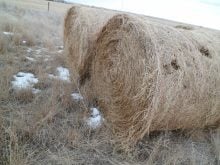Everyone’s predicting a big drop in U.S. winter wheat acres.
But no one is calling for that to create a bull market for wheat. That’s because stocks are so big in the United States and around the world that a little less U.S. wheat in 2010 won’t do much to change the world supply and demand.
“It’s not going to make a huge difference,” said Mike Krueger, a grain market analyst with The Money Farm in Fargo, North Dakota, as he awaited the Jan. 12 string of U.S. Department of Agriculture reports that detail winter wheat acreage, the final production numbers for 2009, and the world supply and demand situation.
Read Also

Input companies complain of regulation creep
Canada’s competitiveness is at risk if federal agencies don’t streamline approval processes and take farmers’ costs into consideration.
“We’ve been thinking about this big reduction in winter wheat acres for quite a while and I don’t think it’s going to have much of an influence on the market.”
Analytical firms polled by Reuters News Service estimated total winter wheat acreage between 38.39 million acres and 42.5 million, a hefty drop from 2009’s 43.31.
The largest drop was in soft red winter wheat, which is grown in the eastern Midwest and could see its acreage fall to between 5.86 and 8.1 million acres from last year’s 8.31 million, with an average guess of a 16 percent drop in acres.
Hard red winter wheat, which competes more directly with Canadian hard red spring wheat, is expected to fall less, to an average analyst guess of 30.2 million acres from last year’s 31.65 million.
The range of analyst estimates is large, which is a product of the harvest problems thousands of U.S. farmers faced in the fall. How much of the intended winter wheat acreage American farmers managed to seed is a question hotly debated by analysts and won’t likely be resolved until spring.
While a major drop in the growing area for winter wheat might seem a bullish factor, huge world stocks of wheat and the comparatively good condition of the U.S. winter wheat crop as it went into dormancy in late 2009 doused hopes that production would fall low enough in 2010 to significantly change the supply and demand situation.
As of Dec. 6, 63 percent of the U.S. winter wheat crop was rated good to excellent, 31 percent was fair and only six percent was rated poor to very poor. That’s about as good as in 2008, and much better than in 2005, 2006 and 2007.
Around the world, not only are stocks large, but also other winter wheat crops appear to be in decent shape.
The dramatic snowstorms and cold weather that have gripped Western Europe and northeastern China have not been severe enough to hurt planted crops, according to Canadian Wheat Board crop conditions analyst Bruce Burnett.
“We haven’t really seen a lot of winterkill,” said Burnett.
While Western European conditions look bad because of the snow, temperatures have dropped only to -2 to -3 C. In colder areas that produce more winter wheat, such as Ukraine, conditions have not been severely worse than in usual years.
Current price projections for 2010 suggest that farmers will earn the most from growing lentils, peas, canola, soybeans and sunflowers, so regardless of a reduced acreage of winter wheat, northern farmers will be unlikely to seed extra acres to spring wheat.
“All those other crops look better than wheat or barley,” Krueger said.
For information on the Jan. 12 USDA reports, visit the daily news section at www.producer.com.















